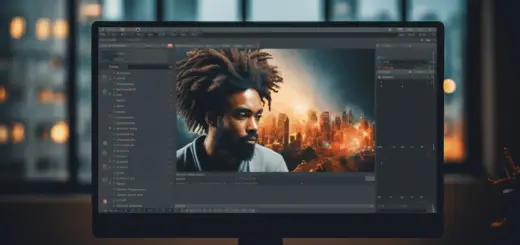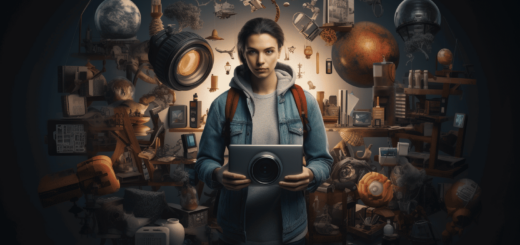Advancing Photography Skills with AI Image Processing
In today’s digital age, photography has become more accessible than ever before. With the rise of smartphones and affordable DSLR cameras, anyone can capture a moment with just a click. However, taking a great photo goes beyond simply pointing and shooting. It requires skill, creativity, and a deep understanding of the technical aspects of photography.
Fortunately, advancements in artificial intelligence (AI) have revolutionized the field of image processing, offering photographers powerful tools to enhance their skills and produce stunning visuals. AI algorithms can automatically analyze and manipulate images to improve their quality, identify objects and scenes, and even generate new images.
This article explores the role of AI in image processing and how it is revolutionizing editing workflows in the photography industry. We’ll also discuss the various applications of AI in photography, from facial recognition to autofocusing, and delve into the future possibilities of AI in this field.
Join us on this exciting journey as we dive into the world of AI and its impact on advancing photography skills. Whether you’re a beginner photographer or a seasoned professional, this article will provide valuable insights into how AI can elevate your craft and help you create breathtaking images that capture the essence of the moment. So, let’s begin exploring the fascinating world of AI image processing in photography.
The Role of AI in Image Processing
With the rapid advancements in technology, artificial intelligence (AI) has emerged as a game-changer in various fields. One area where AI has made significant strides is image processing. By leveraging computational power and advanced algorithms, AI has revolutionized the way we analyze and enhance images.
Image Restoration
One of the most remarkable applications of AI in image processing is image restoration. AI-powered algorithms can effectively repair old or damaged photographs, bringing them back to life with impressive accuracy and detail. By analyzing existing data and patterns, AI can fill in missing information, remove noise and artifacts, and restore the image to its former glory. This capability has proven invaluable in preserving historical photographs and cherished memories for future generations.
Object and Scene Identification
AI excels in the task of object identification and scene understanding. Using sophisticated machine learning algorithms, AI can analyze images to detect and identify various objects present in the scene. This has immense practical implications, ranging from autonomous vehicles recognizing traffic signs and pedestrians to computer vision systems identifying objects for inventory management or surveillance purposes.
Culling and Focus Detection
For professional photographers, sorting through hundreds or even thousands of photos can be a time-consuming task. AI-powered software comes to the rescue by automating the culling process. By using machine learning algorithms, these tools can analyze images based on various factors such as focus, exposure, composition, and facial recognition. This allows photographers to quickly identify the best shots and save valuable time in the editing process.
Contrast Adjustment and Color Correction
AI algorithms also play a crucial role in contrast adjustment and color correction. By analyzing the image’s histogram, AI can intelligently adjust the brightness and contrast levels to enhance overall image quality. Additionally, AI can automatically correct color imbalances, ensuring accurate and vibrant colors in the final image. This makes image editing more efficient and helps photographers achieve the desired visual effects.
Pattern Recognition and Object Detection
Pattern recognition and object detection are two essential aspects of image processing. AI algorithms excel in these tasks by leveraging deep learning techniques. By analyzing vast amounts of data, AI can identify patterns, recognize objects, and even learn to detect and classify new objects. This ability has far-reaching implications in various domains, including security, healthcare, and robotics.
Image Manipulation
AI-powered image manipulation has taken editing capabilities to new heights. With AI, complex tasks such as removing unwanted objects, changing backgrounds, or even altering facial expressions have become more accessible. These advanced algorithms analyze the image, understand the context, and generate seamless edits that blend effortlessly. This not only saves time but also allows for more creative freedom in transforming images.
In conclusion, AI has transformed the field of image processing with its ability to analyze, enhance, and manipulate images. From restoring old photographs to automating tasks for photographers, the applications of AI in image processing are vast and continually expanding. As technology continues to advance, we can expect even more groundbreaking developments in the intersection of AI and image processing.
To learn more about AI image processing tools and techniques, check out Wimarys’ AI Image Processing Tools.
Revolutionizing Editing Workflows with AI
With the rapid advancements in AI technology, the field of photography is going through a major transformation. AI-assisted editing techniques are revolutionizing workflows and providing photographers with innovative tools to enhance their images. From automated editing to real-time image analysis and post-processing improvements, AI is making its mark in the world of photography editing.
Automated Editing
AI algorithms have the capability to automatically adjust various aspects of an image, saving photographers time and effort. Imagine being able to quickly enhance the lighting, color balance, and sharpness of your photos with just a few clicks. AI-powered editing software can analyze the content of an image and make intelligent adjustments based on predefined parameters.
- AI algorithms automatically adjust lighting, color balance, and sharpness.
- Saves photographers time and effort.
- Intelligent adjustments based on predefined parameters.
Real-time Image Analysis
One of the most exciting developments in AI-assisted editing is real-time image analysis. This feature allows photographers to see a live analysis of their images as they make adjustments, providing instant feedback and guidance. With real-time image analysis, photographers can make informed decisions about exposure, composition, and other elements of their photos.
“Features like real-time image analysis have the potential to change editing workflows for photographers.” [^1]
- Real-time analysis provides instant feedback and guidance.
- Helps photographers make informed decisions about exposure and composition.
- Can potentially change editing workflows for photographers.
Post-processing Image Improvement
AI can also be used in post-processing to analyze and improve image quality. By leveraging machine learning algorithms, AI-powered editing software can automatically reduce noise, enhance details, and correct imperfections in photos. This level of automation and precision allows photographers to achieve professional-quality results with minimal effort.
“AI can be used in post-processing to analyze and improve image quality.” [^1]
- AI analyzes and improves image quality in post-processing.
- Reduces noise, enhances details, and corrects imperfections.
- Enables photographers to achieve professional-quality results with minimal effort.
In conclusion, AI-assisted editing techniques are transforming the photography editing landscape. From automated adjustments to real-time image analysis and post-processing improvements, AI is empowering photographers with powerful tools to enhance their images. By incorporating AI into their workflows, photographers can save time, improve image quality, and unlock new levels of creativity.
Take a deep dive into AI-assisted editing techniques and elevate your photography skills here.
AI Applications in the Photography Industry
The photography industry has seen significant advancements with the integration of Artificial Intelligence (AI). AI-based technologies are revolutionizing the way photographs are captured, processed, and enhanced. From facial recognition to image generation, AI is unlocking new frontiers of visual storytelling in the world of photography.
Facial Recognition
AI has transformed the way photographers capture portraits and identify individuals in a photograph. Facial recognition algorithms can analyze facial features, expressions, and even emotions, providing valuable insights for photographers. This technology has numerous applications, including:
- Automatic tagging of individuals in a photo collection.
- Enhancing focus on specific faces during post-processing.
- Streamlining the organization and categorization of photos based on the people present.
Image Generation
AI-powered algorithms have opened up a world of possibilities for creating unique, high-quality images. Using trained neural networks, these algorithms can generate images from scratch, mimicking the style and composition of human photographers. Some applications of AI-based image generation in photography include:
- Creating stunning landscapes or cityscapes that look like they were captured by a professional photographer.
- Generating unique artistic styles and filters, offering photographers new creative avenues.
- Generating realistic images in scenarios where capturing a photograph is not feasible or safe.
Autofocusing
Accurate autofocus is crucial for capturing sharp and well-focused photographs. AI-based autofocus systems have taken this to a whole new level by employing sophisticated algorithms to detect and track human eyes and even animal faces. These autofocus systems can adapt to different lighting conditions and subject movement, ensuring sharp focus in every shot. The key benefits of AI-based autofocus systems are:
- Improved accuracy and precision in capturing images with sharp focus on the desired subject.
- Faster and more reliable autofocus performance, especially in challenging shooting conditions.
- Enhanced subject tracking capabilities, enabling photographers to capture fast-moving subjects with ease.
Exposure and Lighting Adjustments
Proper exposure and lighting are vital elements in photography. AI algorithms can analyze the scene and make intelligent adjustments to optimize exposure, brightness, and contrast. AI-powered systems can intelligently adapt to the lighting conditions and scene complexity, resulting in well-balanced and aesthetically pleasing photographs. Some advantages of AI-driven exposure and lighting adjustments include:
- Ensuring accurate exposure in challenging lighting situations, such as high contrast or low light.
- Enhancing dynamic range in photographs, preserving details in both highlights and shadows.
- Simplifying post-processing by automatically adjusting exposure, reducing the need for manual adjustments.
These are just a few examples of AI applications in the photography industry. The widespread adoption of AI technology is transforming the way photographers capture, process, and enhance their images, pushing the boundaries of visual storytelling. As AI continues to advance, we can expect further innovations and improvements in the world of photography.
To learn more about the impact of AI on photography and how it is unlocking new frontiers of visual storytelling, visit here.
The Future of AI in Photography
It’s no secret that AI has already made significant strides in the field of photography. From image recognition technology to advanced photo editing tools, AI has revolutionized the way we capture, edit, and restore photographs. But what does the future hold for AI in photography? Let’s take a closer look at some exciting developments that are shaping the future of this dynamic field.
Continual Growth and Advancement
AI’s impact on photography is far from reaching its peak. In fact, experts predict that AI’s use in photography will continue to grow and advance in the coming years. As technology continues to progress, we can expect to see even more innovative applications of AI in various aspects of photography. From capturing breathtaking images to simplifying the editing process, AI is set to play a significant role in shaping the future of this art form.
Generative AI Tools
One of the most fascinating developments in AI for photography is the rise of generative AI tools. These tools utilize deep learning algorithms to generate photorealistic images and create new content in response to prompts. Imagine being able to generate stunning landscapes, lifelike portraits, or even abstract art with just a few clicks. Generative AI tools have the potential to revolutionize the creative process for photographers, allowing them to explore new artistic horizons and push the boundaries of their craft.
Revolutionizing Photo Restoration
AI is also revolutionizing the field of photo restoration. In the past, restoring old and damaged photographs was a time-consuming and labor-intensive process. However, with the advent of AI-powered restoration tools, this once arduous task has become quicker, more precise, and accessible to a wider audience. AI algorithms can analyze and repair damaged images, restoring lost details and enhancing the overall quality. This not only preserves precious memories but also opens up new opportunities for photographers and historians to explore and visualize the past in a whole new light.
These exciting advancements in AI technology are just the beginning of what the future holds for photography. As AI continues to evolve, we can expect even more breakthroughs in image recognition, editing tools, and creative applications. Whether you’re a professional photographer or an avid enthusiast, embracing AI in your workflow can enhance your creative process and empower you to capture and create stunning images that were once beyond imagination.
Conclusion
In conclusion, the role of AI in image processing has revolutionized the world of photography. With advancements in technologies such as image restoration, object identification, and real-time analysis, photographers now have access to powerful tools that enhance their editing workflows and improve the quality of their images. AI applications have also made significant contributions to the photography industry, enabling features like facial recognition, image generation, and autofocusing.
As we look to the future, the continual growth and advancement of AI will undoubtedly bring forth even more innovative tools and techniques, further revolutionizing the field of photography.
For those interested in exploring the world of photography and harnessing the power of AI, Wim Arys Photography is a fantastic resource. Wimarys.com offers a wealth of tutorials, reviews, tips, and tricks related to photography and cameras, with a specific focus on Sony mirrorless cameras. Visit the website to find helpful articles, camera reviews, and inspiration for your photography projects. Start your journey towards advancing your photography skills and creating stunning images today.
Frequently Asked Questions
- What is AI image processing?
AI image processing refers to the use of artificial intelligence techniques, such as computer vision and machine learning, to analyze, enhance, and manipulate digital images.
- How can AI image processing help in advancing photography skills?
AI image processing can assist photographers in various ways, such as improving image quality, enhancing colors and details, removing noise, adjusting exposure, and automatically identifying and categorizing objects in photos.
- Are there any specific AI image processing tools or software for photographers?
Yes, there are several AI image processing tools and software available specifically for photographers. Some popular options include Adobe Photoshop, Lightroom, Skylum Luminar, and Topaz Labs AI tools.
- Do I need special skills or knowledge to use AI image processing tools?
While having some basic understanding of image editing and the specific AI tool you are using can be helpful, many AI image processing tools have user-friendly interfaces and offer automatic or guided features that can be used by beginners as well.
- Can AI image processing completely replace traditional photography skills?
No, AI image processing cannot completely replace traditional photography skills. It can assist and enhance the photographer’s work, but fundamental knowledge of composition, lighting, and manual camera settings is still essential for capturing high-quality photographs.



